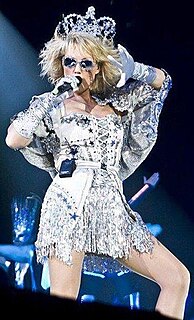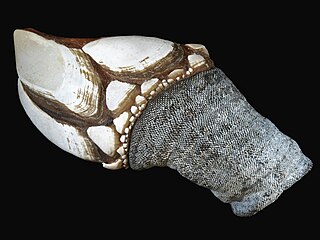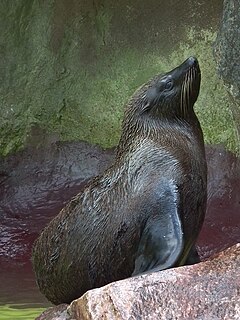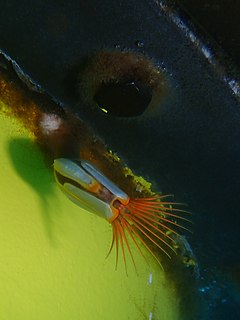
The hardhead, also known as the white eyed duck, is the only true diving duck found in Australia. The common name "hardhead" has nothing to do with the density of the bird's skull, instead referring to the difficulty encountered by early taxidermists in processing the head. Hardheads are found in wetter, coastal regions of Australia, particularly in the south-east, but are known to disperse as far afield as New Guinea, New Zealand, and the Pacific Islands.

The southern right whale is a baleen whale, one of three species classified as right whales belonging to the genus Eubalaena. Southern right whales inhabit oceans south of the Equator, between the latitudes of 20° and 60° south. In 2009 the global population was estimated to be approximately 13,600.

The weka is a flightless bird species of the rail family. It is endemic to New Zealand. Four subspecies are recognized but only two (northern/southern) are supported by genetic evidence. Weka are sturdy brown birds, about the size of a chicken. As omnivores, they feed mainly on invertebrates and fruit. Weka usually lay eggs between August and January; both sexes help to incubate.

Fahreta Živojinović, known by her stage name Lepa Brena, is a Bosnian-born Serbian and former Yugoslavian pop-folk singer, actress and businesswoman. She is the best-selling female recording artist from the former Yugoslavia.

Goose barnacles, also called stalked barnacles or gooseneck barnacles, are filter-feeding crustaceans that live attached to hard surfaces of rocks and flotsam in the ocean intertidal zone. Goose barnacles formerly made up the taxonomic order Pedunculata, but research has resulted in the classification of stalked barnacles within multiple orders of the infraclass Thoracica.

Phragmites is a genus of four species of large perennial reed grasses found in wetlands throughout temperate and tropical regions of the world.

The South American fur seal breeds on the coasts of Peru, Chile, the Falkland Islands, Argentina, Uruguay and Brazil. The total population is around 250,000. However, population counts are sparse and outdated. Although Uruguay has long been considered to be the largest population of South American fur seals, recent census data indicates that the largest breeding population of A. a. australis are at the Falkland Islands followed by Uruguay. The population of South American fur seals in 1999 was estimated at 390,000, a drop from a 1987 estimate of 500,000 - however a paucity of population data, combined with inconsistent census methods, makes it difficult to interpret global population trends.

Lepa is a small village at the southeastern end of Upolu island in Samoa. The village has a population of 166.

Phragmites australis, known as the common reed, is a broadly distributed wetland grass growing nearly 20 ft (6 m) tall.

Lepadidae is a family of goose barnacles, erected by Charles Darwin in 1852. There are about 5 genera and more than 20 described species in Lepadidae.

Amanita australis is a species of fungus in the family Amanitaceae. It is found only in New Zealand, where it occurs in Leptospermum and Nothofagus forest. The species was first described by New Zealand mycologist Greta Stevenson in 1962; in the same publication Stevenson also described what she thought was a unique species, Limacella macrospora, but over 30 years later this was reduced to synonymy with A. australis.

The Burrunan dolphin is a proposed species of bottlenose dolphin found in parts of Victoria, Australia first described in 2011. Though the species classification is contested by some, a larger body of evidence now exists, further validating the Burrunan as a separate species to the common and Indo-Pacific bottlenose dolphins. The Burrunan dolphin is not currently recognized as a species by the Society for Marine Mammalogy, which cites problematic methodology in the original study proposing species status and recommends further research.

Lepas is a genus of goose barnacles in the family Lepadidae.

Lepas anatifera, commonly known as the pelagic gooseneck barnacle or smooth gooseneck barnacle, is a species of barnacle in the family Lepadidae. These barnacles are found, often in large numbers, attached by their flexible stalks to floating timber, the hulls of ships, piers, pilings, seaweed, and various sorts of flotsam.

Dryococelus australis, commonly known as the Lord Howe Island stick insect or tree lobster, is a species of stick insect that lives on the Lord Howe Island Group. It is the only member of the monotypic genus Dryococelus and was thought to be extinct by 1920, only to be rediscovered in 2001. It is extirpated in its largest former habitat, Lord Howe Island, and has been called "the rarest insect in the world", as the rediscovered population consisted of 24 individuals living on the small islet of Ball's Pyramid.

Lepas hillii is a species of goose barnacle in the family Lepadidae.

Lepas indica is a species of goose barnacle in the family Lepadidae.

Lepas pectinata, the small goose barnacle, is a species of goose barnacle in the family Lepadidae.

Lepas testudinata is a species of goose barnacle in the family Lepadidae.


















